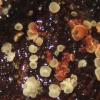
04-01-2026 17:45
 Stephen Martin Mifsud
Stephen Martin Mifsud
I was happy to find these orange asmocyetes which

03-01-2026 13:08
Niek SchrierHi all,We found groups of perithecia on a Lecanora

29-12-2025 17:44
Isabelle CharissouBonjour,J'aimerais savoir si d'autres personnes au

02-01-2026 17:43
MARICEL PATINOHi there, although I couldn't see the fruitbody, I

01-01-2026 18:35
Original loamy soil aside a artificial lake.The co

31-12-2025 19:27
Collected from loamy soil, at waterside (completel
Calycina conorum
Yannick Mourgues,
01-02-2008 23:49
 Bonsoir.
Bonsoir.J'ai observé que Calycina conorum rougissait fortement à la blessure. Est-ce que l'un d'entre vous saurait pourquoi ? Quelle est la réaction chimique responsable de cela ?
I have watched that Calycina conorum becomes strongly reddening when hurted. Do you know why ? What is the chemical process ?
Merci par avance.
Yannick
Perz Piotr,
02-02-2008 09:39
Re:Calycina conorum
Hi Yannick
I thint this is oxidation of VBs i paraphyses, marginal- & excipulum cells.
Pimpek
I thint this is oxidation of VBs i paraphyses, marginal- & excipulum cells.
Pimpek
Hans-Otto Baral,
02-02-2008 11:38

Re:Calycina conorum
Yes, it is a wide-spread property in Helotiales and always the result of oxidation of refractive vacuoles. Typical of Lachnum, Bryoscyphus, some of Calycina etc. I think it has to do with benzol rings in which the double bindings change through oxidation and therefore get coloured. It is always a lethal process so that redbrown paraphysis or hair cells are never coloured as long as they are alive.
We have so important vital characters like VBs and we know so little about thier chemical background. It would be an interesting field of research for chemistry.
Zotto
We have so important vital characters like VBs and we know so little about thier chemical background. It would be an interesting field of research for chemistry.
Zotto



